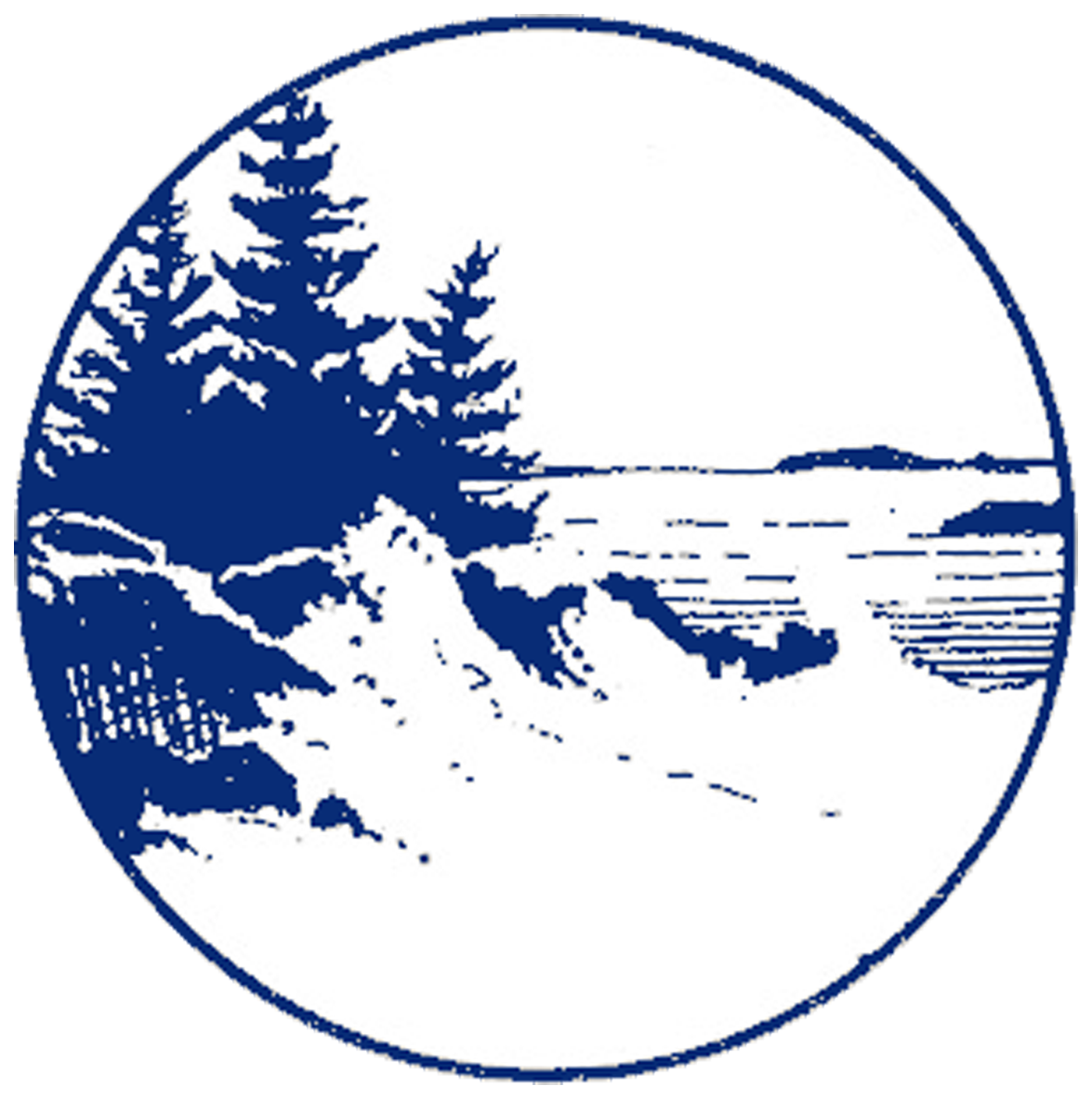Invasive Plants
Introduction
The State of Maine has enacted new rules that ban the sale and distribution of 33 plants that have been deemed invasive and therefore problematic to the state's natural habitats. The plants on the list have invaded farms, fields, forests and wetlands throughout the state. The St. George Conservation Commission has joined with the Department of Agriculture, Conservation and Forestry (DACF) and other State agencies in their mission to identify and eradicate invasive species.
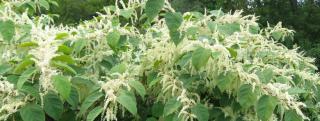
What is an Invasive Plant?
A non-native plant that has naturalized and is reproducing in the wild and harming local ecosystems by out-competing native plants for sunlight, water, soil nutrients, and space.
How do Invasive Plants Become a Problem?
In general, invasive plants spread voraciously and choke out native plants.
Most are innocently planted by people, as they were popular garden plants whose invasive tendencies were not broadly known. For example, barberry was introduced for hedges.
Some hitchhike to areas where there are no natural competitors.
Some have root systems that release chemicals that make the adjacent soil inhospitable to other plants such as Norway Maple.
Many, like Morrow’s honeysuckle, provide fruit that attracts birds with empty calories rather than the lipid rich fruits of native plants.
Some invasive vines, like bittersweet, smother trees by cutting off sunlight.
Why are Native Plants Better?
Native plants support the local web of life.
They are the “host” plants for pollinators, insects, birds and other species.
They leaf out and blossom in sync with area species to provide nectar, food, propagating material, and survival. For example, the in-sync hatching of insects and caterpillars provides irreplaceable protein for parent birds to feed nestlings. Nestlings cannot digest seeds.
They remain in balance in the local ecosystem rather than crowd out local plants.
What Invasive Plants Are a Problem in Maine?
The Maine Dept. of Agriculture, Conservation & Forestry identified 33 land-based plants as invasive and prohibits their sale in Maine. Twelve of these have been identified as most problematic for homeowners.
The “Dirty Dozen”
Norway Maple
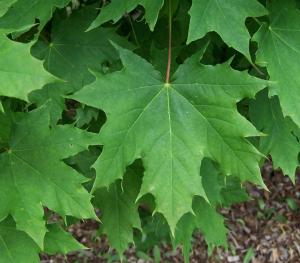
Five-lobed leaves with pointed tips but no teeth. Break the leaf stem where it attaches to the branch and white sap oozes out. They grow quickly, self-seed, and spread rapidly. Their shallow root system inhibits anyhing growing near them. Their dense canopy shades out native trees.
Japanese Barberry (Berberis thunbergii)
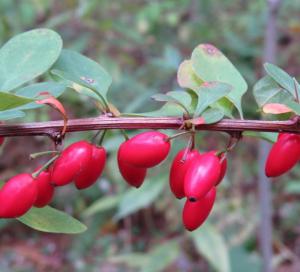
A thorny shrub that alters the forest soil cycling, is widespread and persists in forest understories. Birds, wild turkeys, and grouse relish the berries and spread the seeds far and wide. It is also a tremendous carrier of Lyme Ticks up to 120 infected ticks per acre where it is not contained!
Common Barberry (Berberis vulgaris)
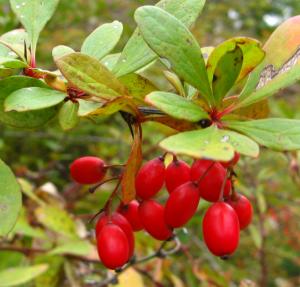
A woody shrub its 3-pronged spines, juicy berries and serrated leaves distinguish it from Japanese barberry. It is a host for the highly damaging wheat rust.
Autumn Olive (Elaeagnus umbellata)
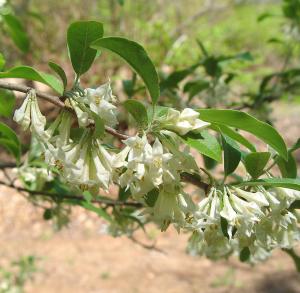
A hardy, prolific plant that thrives in many habitats. It is prolific in berry production in the fall giving it its comon name. Birds and mammals eat the fruit and distribute seeds widely.
Burning Bush (Euonymus alatus)
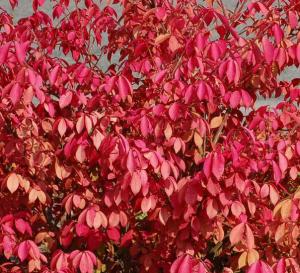
Known for its spectacular, scarlet foliage in the fall. Has flaky wings along its green-brown branches. A popuar ornamental shrub now found along roadsides, forest edges, and fields. Seeds widely spread by birds.
Japanese Knotweed (Fallopia japonica)
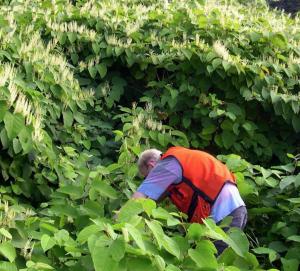
Robust and very tall perennial herb growing in dense stands. One of the most invasive and aggressive invasive weeds. Can sprout from any stem node or rhizome fragment. Very difficult to eliminate.
Glossy Buckthorn (Frangula alnus)
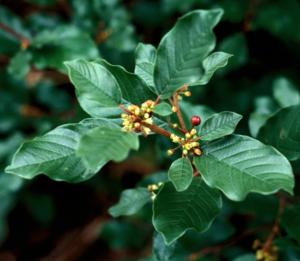
Perennial, deciduous shrub or small tree with shiny leaves and no thorns. White-yellow flowers are five petaled and small. Thrives in forest understories.
Morrow’s Honeysuckle (Lonicera morrowii)
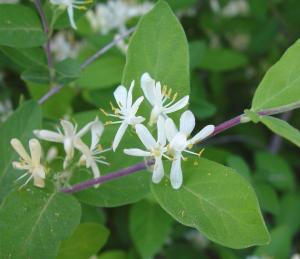
Hollow stemmed shrub with leaves that are hairy on the underside. Reaches largest size in sun but highly shade-tolerant and capable of invading intact forest understory.
Multiflora Rose (Rosa multiflora)
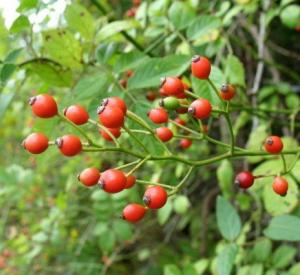
Perennial shrub that can grow over other shrubs and into tree branches. Aptly named for its abundance of white flowers and red berries. Was initially used as rootstock for ornamental roses.
Himalayan Balsam (Impatiens glandulifera)
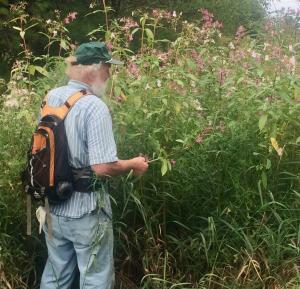
Also known as Ornamental jewelweed, is an annual with hollow stems with teeth on the leaf blades. Pink to purple flowers are helmet shaped and appear midsummer into fall. Ripe pods explode when disturbed.
Asiatic Bittersweet (Celastrus orbiculatus)
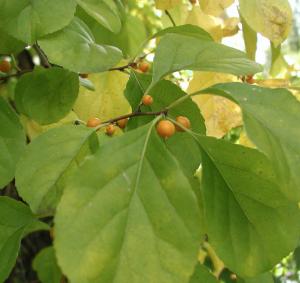
Woody vine that climbs into tree canopies or sprawls over low growing vegetation. Aggressive it tolerates both high sun and deep shade. After leaves have dropped often used in festive wreaths and flower arrangements.
Black Swallowwort (Cynanchum louiseae)
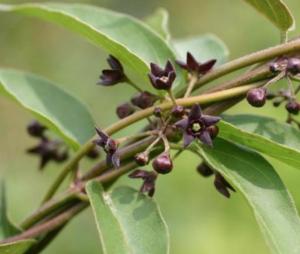
Very invasive vine that forms dense stands and crowds out other vegetation. Flowers are 5-pointed star shaped. Green pods release silken parachutes similar to milkweed. Leaves and roots are toxic to Monarch butterflies. Roots change soil condition which reduces native plant diversity.
How to Deal with Invasives
It takes a while to recognize invasive plants. Often there are look alikes that are actually native plants. Detailed identification resources are available on the web. Some of the most helpful websites are listed below
Once you have identified invasives on your property the next step is to determine how to manage them. There are different approaches to managing and/or eliminating each invasive. Often the source you’ve used for identifying them will also give details and how to eliminate the plants. Another very helpful resource on how to manage and eliminate invasives is available from the Casco Bay Invasive Species Network entitled: Winning the War on Weeds.
Ongoing Work
The Commission continues to provide educational resources and periodic workshops. Please see our education page.
The Commission provides ongoing monitoring of town trails and properties for invasives.
For more information please check out these informative websites:
Invasive plants and native alternatives are listed on the Maine Horticulture Program here.
The Knox-Lincoln Soil and Water Conservation District has helpful information on local invasives here.
The Maine Invasive Plants Field Guide along with other helpful information is available from the Maine Natural Areas Program, Department of Agriculture, Conservation and Forestry.
References
Below are two videos produced by the University of Maine that provide great information on identifying invasive and best ways to eliminate them.
